Samaaro + Your CRM: Zero Integration Fee for Annual Sign-Ups Until 30 June, 2025
- 00Days
- 00Hrs
- 00Min
India’s event marketing landscape is evolving rapidly, driven by its diverse cultural heritage, digital transformation, and the growing demand for personalized experiences. With over 900 million internet users, many of whom prefer regional content, event marketers must adopt localized strategies to maximize engagement and attendance.
Traditional, one-size-fits-all event promotions no longer yield the best results. Instead, a blend of vernacular content, WhatsApp promotions, influencer collaborations, and region-specific outreach is essential to connect with India’s vast and varied audience. This blog explores the key strategies for event marketing in India in 2025, covering vernacular promotions, digital ad preferences, payment trends, and WhatsApp-based outreach to help event organizers drive success in this dynamic market.
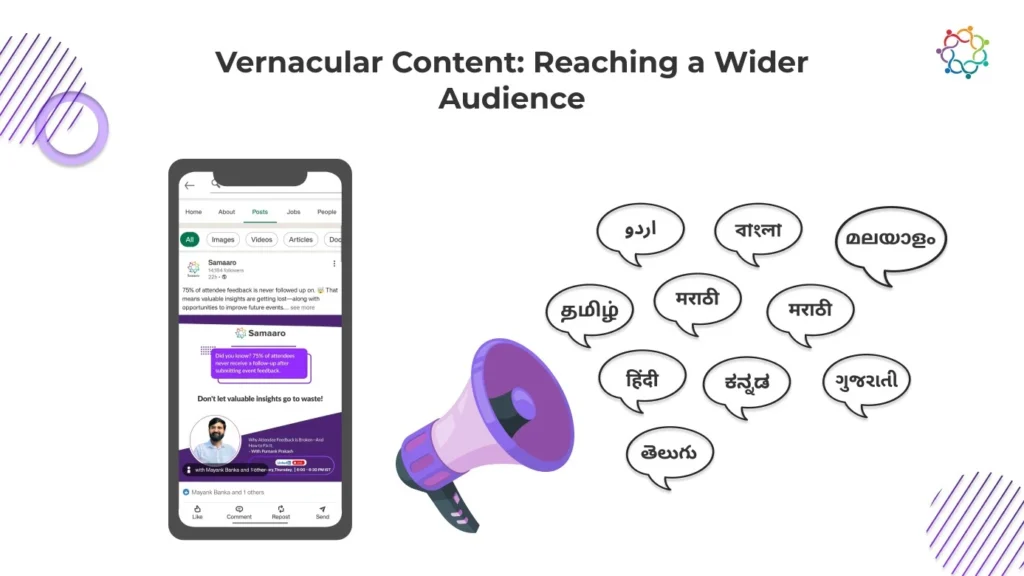
India is a multilingual nation where English is not the primary language for most internet users. According to a recent report, over 70% of India’s internet users prefer consuming content in regional languages. Platforms like YouTube, ShareChat, and Moj have witnessed a surge in regional language content, reflecting the shift away from English-dominated digital spaces.
To maximize event attendance, organizers must cater to this linguistic diversity by creating marketing materials that resonate with regional audiences. Research shows that vernacular content improves engagement rates and builds trust among attendees, especially in Tier 2 and Tier 3 cities.
Regional influencers play a pivotal role in connecting with local communities. Event marketers can collaborate with micro and nano influencers who have a deep cultural understanding of their audience. These influencers can create authentic event promotions in their native languages, significantly improving engagement and attendance.
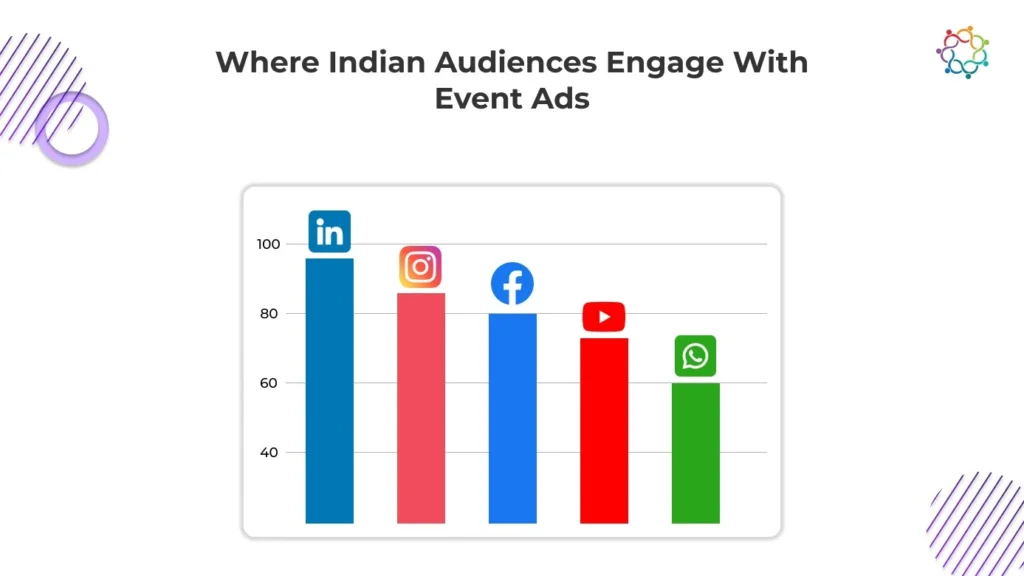
Understanding the platforms where Indian audiences engage the most is crucial for effective event marketing. The most popular digital channels for event promotions in 2025 include:
Event marketing in India thrives on building communities. Successful event brands create:
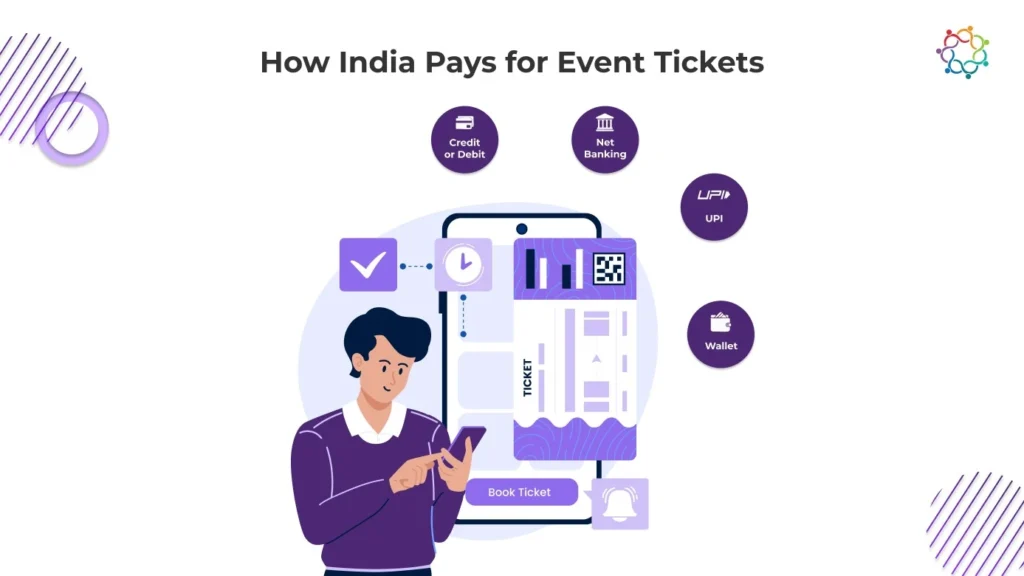
India leads in digital payments, with UPI (Unified Payments Interface) accounting for over 75% of online transactions. Event organizers must integrate UPI-based payments, QR codes, and mobile wallets for seamless ticket purchases. Other trends include:
With over 500 million active WhatsApp users in India, the platform is a key driver for event promotions. WhatsApp’s high open rates and direct engagement capabilities make it an invaluable tool for event organizers.
Influencers have become the backbone of event marketing in India. Brands are increasingly leveraging micro and nano influencers who have niche, engaged communities. Popular platforms include:
Marketing events in India requires a localized, multi-channel approach that incorporates vernacular content, WhatsApp marketing, digital payments, and influencer collaborations.
Samaaro’s event marketing solutions are designed to help organizers implement these strategies seamlessly. Key features include:
Are you ready to scale your event marketing in India? Explore how Samaaro can help you reach your audience effectively!
Getting people to register for an event is just the beginning. The real challenge is keeping them engaged and ensuring they actually attend. Many registrants lose interest due to lack of communication, unclear event value, or competing priorities.
Event nurturing is the process of keeping attendees engaged, excited, and committed leading up to the event. With strategic engagement, personalized communication, and the right technology, organizers can significantly reduce no-show rates and increase participation.
This blog explores why event nurturing is essential, how to segment and personalize attendee engagement, and the best tactics to keep registrants engaged until event day.

A successful event doesn’t begin on the day it takes place—it starts from the moment attendees register. Keeping registrants engaged before the event ensures they remain excited, prepared, and committed. Without continuous engagement, there’s a higher chance of drop-offs and reduced participation.
Many registrants drop off due to lack of interaction after signing up. Engaged attendees, on the other hand, feel more invested in the event and are more likely to show up.
Excitement drives attendance. Creating a sense of anticipation through exclusive sneak peeks, speaker announcements, and pre-event activities ensures attendees look forward to the event.
Frequent communication that highlights key sessions, exclusive content, and networking opportunities reinforces why the event is worth attending.
Pre-event networking opportunities, interactive content, and behind-the-scenes insights help attendees feel connected before the event even starts.
AI-powered engagement tools can track attendee interest levels and send targeted content based on behavior. Event apps, chatbots, and analytics dashboards help tailor engagement strategies effectively.

Every attendee has different expectations and interests when registering for an event. By leveraging automation and segmentation, organizers can provide a more personalized and engaging experience that caters to these individual needs.
Not all attendees are the same. By segmenting registrants based on interests, registration type, and past interactions, organizers can personalize content and outreach.

Once attendees register for an event, maintaining their interest and ensuring they don’t forget about it is crucial. A well-crafted reminder strategy goes beyond generic emails—it should be timely, interactive, and personalized to create a sense of anticipation. By leveraging multiple communication channels such as WhatsApp, AI-driven messaging, and engaging email sequences, organizers can keep attendees informed and excited about the event.
WhatsApp has become a powerful tool for real-time engagement. Unlike emails, WhatsApp messages have significantly higher open rates, making them ideal for sending reminders. Event organizers can use WhatsApp to provide quick RSVP confirmations, share direct links to the event platform, and even allow two-way communication where attendees can ask last-minute questions. Automated reminders sent via WhatsApp can also include countdowns, key session updates, and venue details to keep attendees prepared.
Emails remain a vital part of event nurturing when done strategically. Instead of sending generic reminders, a structured drip campaign can provide attendees with valuable insights leading up to the event. Personalized email sequences can include:
By offering engaging content rather than just reminders, emails become an exciting part of the event journey rather than an obligation.
Artificial intelligence can help refine event nurturing by sending reminders based on attendee behavior. AI-driven reminders can:
These smart, data-driven interactions ensure that reminders feel natural and relevant rather than intrusive.
Instead of plain text messages, interactive reminders can add an element of fun and engagement. Countdown GIFs, interactive polls, and sneak peeks into the event’s biggest highlights can make reminders feel more exciting. Offering exclusive content, such as behind-the-scenes footage or early access to event perks, can further enhance engagement and encourage attendance.
By implementing a multi-channel, personalized approach to reminders, event organizers can ensure registrants remain engaged, well-informed, and excited right up until the event day.
Keeping registrants engaged after they sign up is crucial to ensuring they attend. A well-planned engagement strategy can create excitement, build anticipation, and foster connections even before the event starts. Organizers should focus on delivering interactive content, exclusive insights, and personalized experiences to keep attendees interested and involved.
Keeping registrants engaged from the moment they sign up until event day requires a mix of personalized engagement, automation, and interactive strategies. Through AI-powered reminders, gamified participation, and exclusive pre-event activities, event organizers can significantly improve attendance rates.
Samaaro’s event marketing platform is designed to streamline this process with features such as:
Ready to maximize event engagement? Explore how Samaaro can help today!
Securing event registrations is just the first step—getting attendees to actually show up is the real challenge. Many organizers struggle with high no-show rates, often due to scheduling conflicts, lack of perceived value, or simple forgetfulness.
So how can event marketers bridge the gap between sign-ups and attendance? The answer lies in strategic engagement, data-driven reminders, and the use of behavioral psychology.
In this blog, we’ll explore why attendees drop off, how to implement effective event reminder strategies, the role of gamification, and on-the-day tactics to ensure maximum participation.

Understanding why people sign up but fail to attend is crucial. Here are the common reasons and how to counter them:
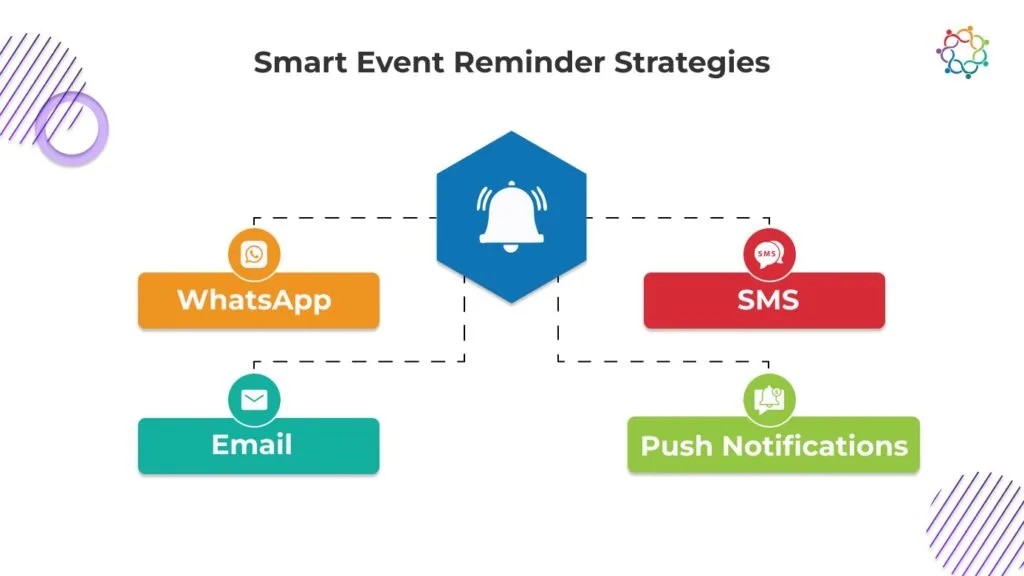
Traditional email reminders are often ignored. A multi-channel approach ensures better engagement.
Gamification adds an interactive and rewarding element to event participation.
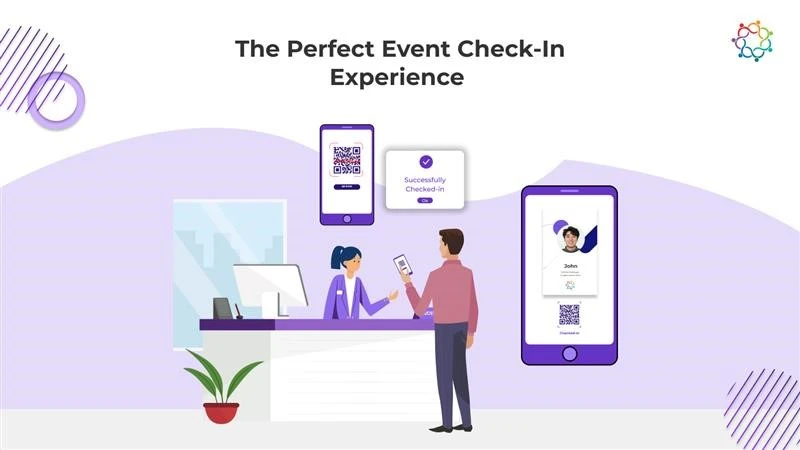
Even after reminding attendees, some may still hesitate to join. Keeping them engaged from the moment they check in is crucial.
Ensuring that attendees return for future events is just as important as getting them to show up in the first place.
Maximizing event attendance requires a strategic mix of personalized engagement, smart reminders, gamification, and real-time interaction. By addressing the reasons behind no-shows, implementing multi-channel reminders, and leveraging AI-powered attendee insights, event organizers can significantly improve turnout rates.
Samaaro’s event marketing platform offers all these capabilities and more. From automated reminders to AI-driven engagement tools and gamified participation features, Samaaro ensures that your audience moves from just clicking ‘Register’ to actually attending.
Ready to boost your event attendance? Explore Samaaro’s solutions today!
Event marketing success isn’t just about promotion—it’s about understanding human psychology. Why do people choose to attend some events over others? What triggers make them register instantly rather than delay?
The answer lies in leveraging psychological principles that drive action. By integrating these principles with advanced event technology and data-driven marketing strategies, brands can increase event attendance and ensure maximum engagement.
In this blog, we’ll explore key psychological triggers, how to use FOMO for event marketing, data analytics strategies, and omnichannel marketing techniques to craft high-impact event campaigns.

Understanding and leveraging psychological triggers can significantly boost event registrations. Here’s how:
People are more likely to register for an event if they see others doing the same. Social proof comes in many forms, including:
Displaying real-time registrations and attendee lists can reinforce social proof, making people feel like they’re part of a larger community.
People feel inclined to return a favor when they receive something of value. In event marketing, you can apply this principle by offering:
By giving before asking, you create a stronger incentive for attendees to register.
Limited availability drives demand. To implement scarcity and urgency, consider:
People trust industry leaders and experts. Establish credibility by:
Small commitments lead to larger commitments. Engage potential attendees early by:
Once attendees invest in small actions, they’re more likely to complete the registration process.

Fear of missing out (FOMO) is a powerful motivator. Event technology can amplify FOMO by creating a buzz around your event.
Showcasing real-time registration numbers on the event page signals high demand and encourages sign-ups.
Gated content, invite-only sessions, and private networking groups create exclusivity, making attendees feel special.
Dynamic seat availability indicators (e.g., “Only 10 seats left!”) prompt quicker registrations.
AI-powered personalized event highlights and interactive content (like Q&A sessions with speakers) drive interest.
Encouraging past attendees to share experiences using event-specific hashtags builds credibility and anticipation.

Data-driven decision-making enhances event marketing effectiveness. Here’s how data analytics can help:
Tracking registration trends, drop-off points, and engagement levels helps refine marketing strategies.
Experiment with different email subject lines, CTA buttons, and landing page designs to determine what drives conversions.
Using AI-powered recommendations, tailor event content based on attendee preferences and past behavior.
Track heatmaps, dwell time, and interaction data to optimize event content and session formats.
Forecasting registration numbers and attendance rates allows better resource allocation and event planning.
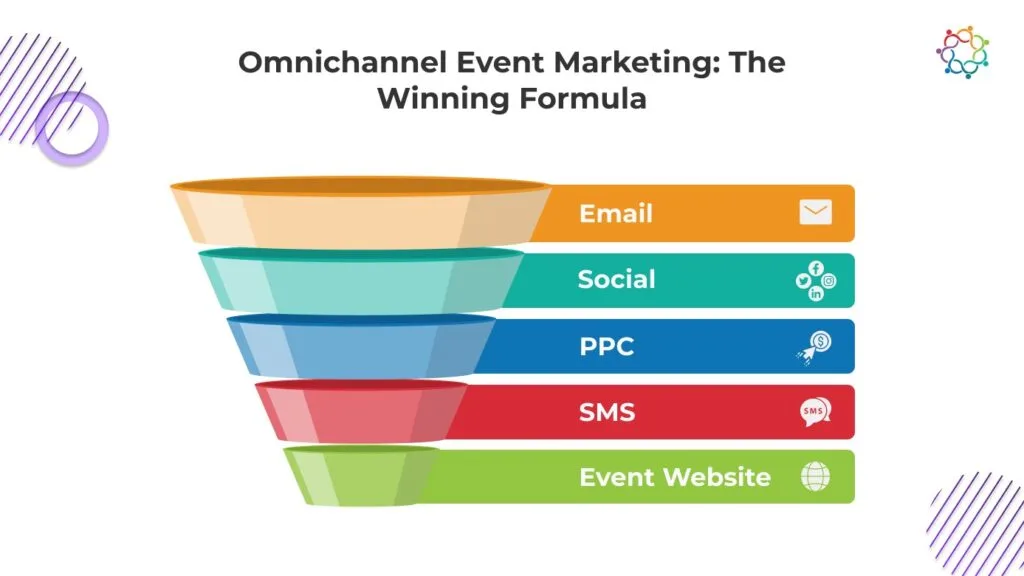
A multi-channel marketing approach ensures maximum reach and engagement. Here’s how to integrate different channels:
Successful event marketing combines psychology, data analytics, and omnichannel strategies. By leveraging social proof, urgency, and personalization, brands can drive higher event attendance.
Samaaro’s event marketing platform integrates these best practices, offering AI-powered analytics, engagement tools, and automated workflows to optimize campaigns. From personalized attendee journeys to real-time engagement tracking, our platform empowers brands to craft high-impact events.
Want to elevate your next event marketing campaign? Explore Samaaro’s solutions today.
Event marketing isn’t what it used to be. Gone are the days when a few well-placed ads and email blasts could guarantee a packed venue. Today, attention is scarce, competition is fierce, and capturing your audience’s interest requires a more intelligent, tech-driven approach.
So, how do you cut through the noise and make your event impossible to ignore in 2025? Let’s go beyond the obvious and explore innovative event awareness strategies for 2025 that leverage AI, data, and social media in ways that truly move the needle.
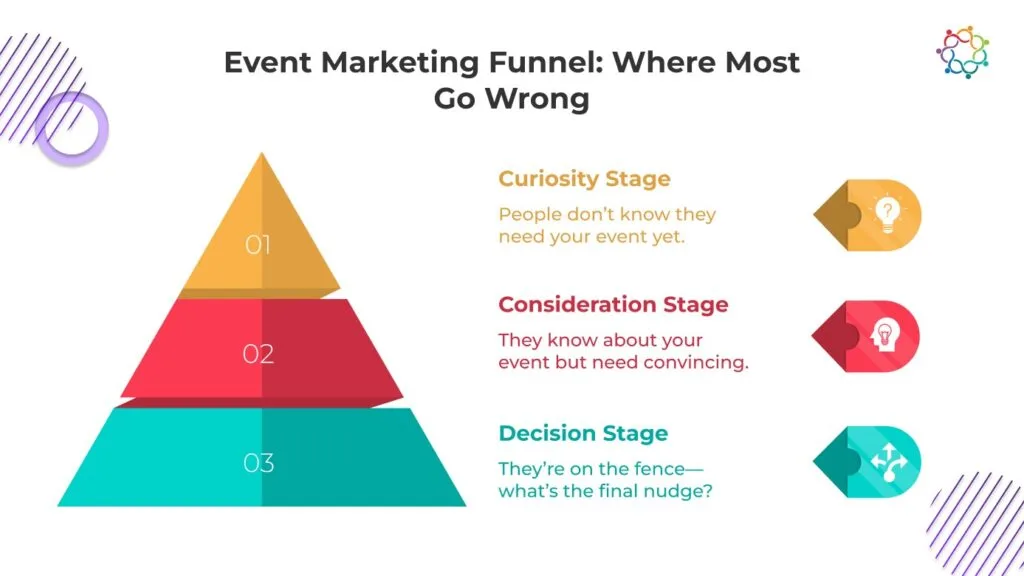
Most event marketers focus too much on the bottom of the funnel—pushing last-minute registrations, discounts, and urgent CTAs. But awareness begins much earlier, and getting this stage right determines how much you’ll struggle (or not) later.
Think of the event marketing funnel in three stages:
Instead of relying on generic promotions, your goal is to craft a strategy that nurtures curiosity, builds credibility, and naturally leads to conversion.
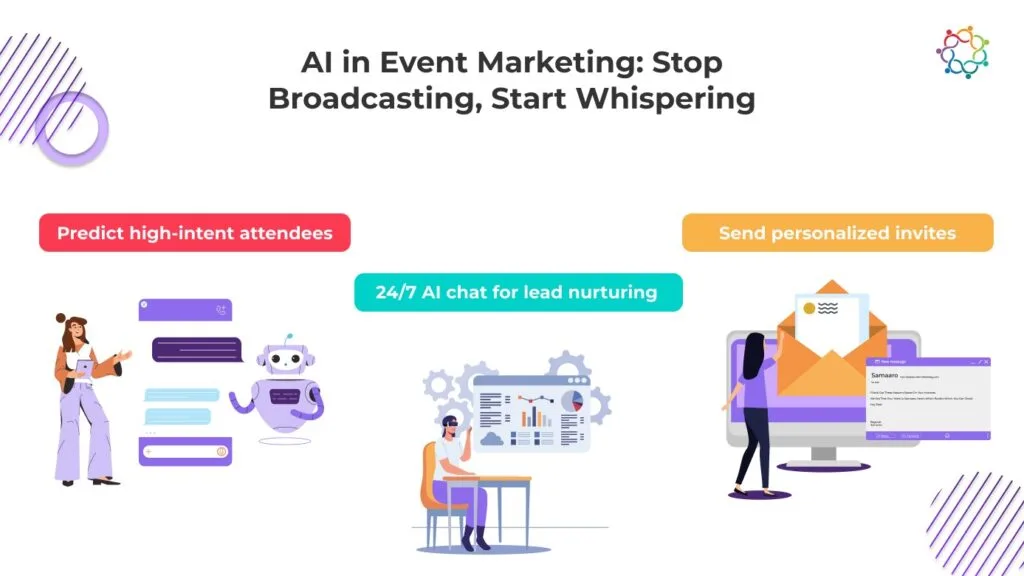
Most marketers still treat event promotion like a megaphone. But people engage with content that feels like a one-on-one conversation, not a mass advertisement.
Example: Instead of blasting a generic “Register Now” email, AI can help segment attendees based on interests. A CMO might receive an invite focused on networking with industry leaders, while a product manager might get insights on product showcases.
Posting a countdown and hoping for registrations? That doesn’t work anymore. Social media should create conversations, not just awareness.
Example: If your event is about AI in marketing, run a poll: “What’s your biggest challenge with AI? a) Personalization b) Scaling Content c) Ethics” and use the responses to shape event sessions.
Most marketers think event engagement starts when the event begins. Wrong. It starts the moment someone interacts with your brand.
Example: If you’re hosting a B2B marketing summit, an AI-powered quiz could suggest: “Based on your responses, these 3 sessions are perfect for you.” That’s far more compelling than a generic event agenda.

Many marketers fall into the trap of tracking impressions and clicks, but these numbers mean nothing if they don’t lead to registrations. Focus on actionable metrics that directly correlate to event success:
Example: If 50,000 people visited your event page but only 500 registered, AI can analyze what’s stopping the other 49,500—whether it’s unclear messaging, poor CTAs, or an unattractive ticketing structure.
Awareness is no longer about being loud—it’s about being strategic, relevant, and data-driven.
Samaaro helps brands navigate this shift with AI-powered audience insights, dynamic social amplification tools, and interactive engagement features that make event promotions feel personal, not generic. Whether you’re looking to refine your funnel, leverage AI for better targeting, or create meaningful social engagement, Samaaro gives you the toolkit to maximize event success.
Employees are the backbone of any organization, and their engagement significantly impacts a company’s success. Engaged employees are more motivated, productive, and loyal to their organizations. However, achieving and maintaining high levels of employee engagement can be challenging, especially in a fast-paced work environment.
Enter micro-events: small, focused gatherings designed to foster meaningful connections and create memorable experiences. These events are not just about celebrations but are tools for enhancing employee morale, team collaboration, and overall productivity. This blog explores how micro-events can become a cornerstone of your employee engagement strategy and how Samaaro can help you plan these events effectively.
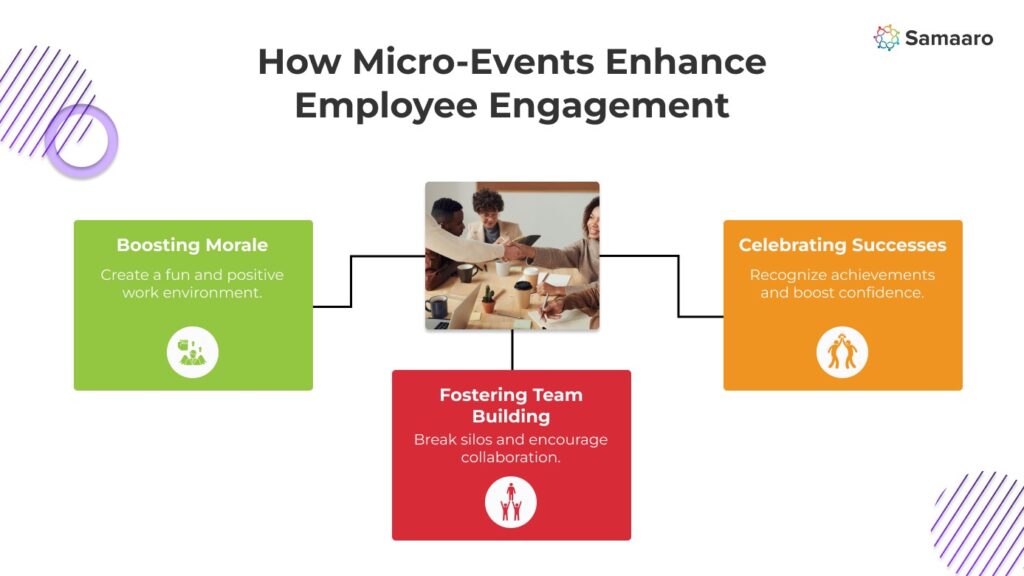
Happy employees are productive employees. Micro-events offer a fantastic way to uplift the mood in the workplace and create a positive environment. A well-timed event can remind employees that their efforts are valued, especially during stressful or high-pressure periods.
Examples of morale-boosting micro-events include:
Recognition plays a critical role in boosting morale. Using micro-events to highlight individual contributions or team efforts ensures employees feel seen and appreciated, fueling their motivation to perform even better.
Micro-events also serve as excellent platforms for team-building activities. Unlike larger gatherings, these intimate settings allow employees to connect on a deeper level, fostering genuine relationships. Team-building micro-events are especially effective in breaking down departmental silos and encouraging cross-functional collaboration.
Examples of team-building micro-events include:
These events not only enhance collaboration but also help employees develop trust and mutual respect, which are essential for a cohesive work environment.
Micro-events are a wonderful way to celebrate milestones and achievements, both big and small. Recognizing accomplishments reinforces a culture of success and motivates employees to strive for excellence.
Examples of celebratory micro-events include:
By celebrating successes, you show employees that their contributions matter, encouraging them to take ownership of their roles.
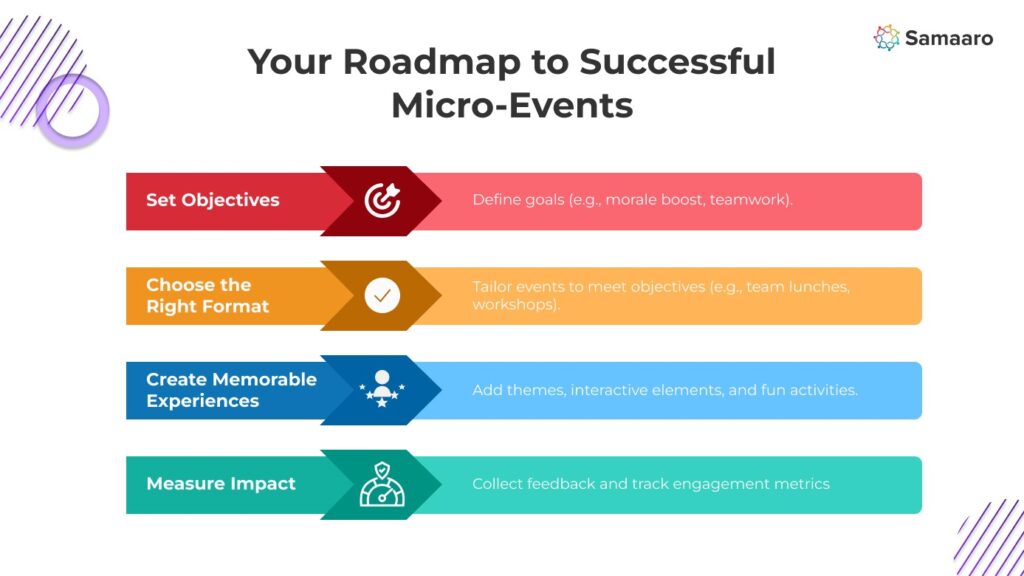
Every micro-event should have a purpose. Whether it’s to recognize achievements, build stronger teams, or simply boost morale, having a clear objective ensures the event is impactful. For instance, a team lunch might aim to improve interdepartmental communication, while a project launch celebration could focus on reinforcing a sense of accomplishment.
The format of your micro-event should align with its goals and your employees’ preferences. For example, if the goal is team building, a collaborative activity like a workshop or volunteer day might be ideal. On the other hand, if the objective is to boost morale, an appreciation event or casual gathering might be more appropriate.
Micro-events, while small in scale, should leave a lasting impact. Incorporate interactive elements, unique themes, or surprise activities to keep employees engaged. Personalized touches, such as customized invitations or tailored recognition, can make the experience even more special.
No engagement strategy is complete without measurement. Gather feedback from employees to understand what they enjoyed and what could be improved. Additionally, track metrics like employee satisfaction scores, attendance rates, and post-event engagement to gauge the event’s success.
Samaaro provides tools to simplify this process, enabling you to analyze event data and measure its impact on employee engagement.
Micro-events are a powerful tool for fostering employee engagement, boosting morale, and enhancing productivity. They create opportunities for meaningful connections, celebrate achievements, and encourage collaboration in ways that traditional large-scale events cannot.
By prioritizing employee engagement and incorporating micro-events into your workplace culture, you can create a positive and productive environment where employees feel valued and motivated to contribute their best.
Samaaro, an AI-powered event marketing platform, can assist you at every stage of micro-event planning—from setting objectives and sourcing venues to managing communications and analyzing results. Ready to transform your workplace with impactful micro-events? Schedule a demo with Samaaro today and see how we can help you create unforgettable experiences for your team.
In the world of event planning, securing the right speakers can be the cornerstone of your event’s success. Great speakers not only captivate your audience but also elevate the reputation of your event, making it memorable for years to come. But where do you find these industry leaders, thought-provoking experts, or inspiring storytellers?
Enter LinkedIn—the ultimate networking platform that doubles as a powerful tool for speaker sourcing. With over 900 million users from diverse industries, LinkedIn offers a treasure trove of potential speakers who can align perfectly with your event’s goals.
Here’s how you can leverage LinkedIn to find and secure top-tier speakers for your events.
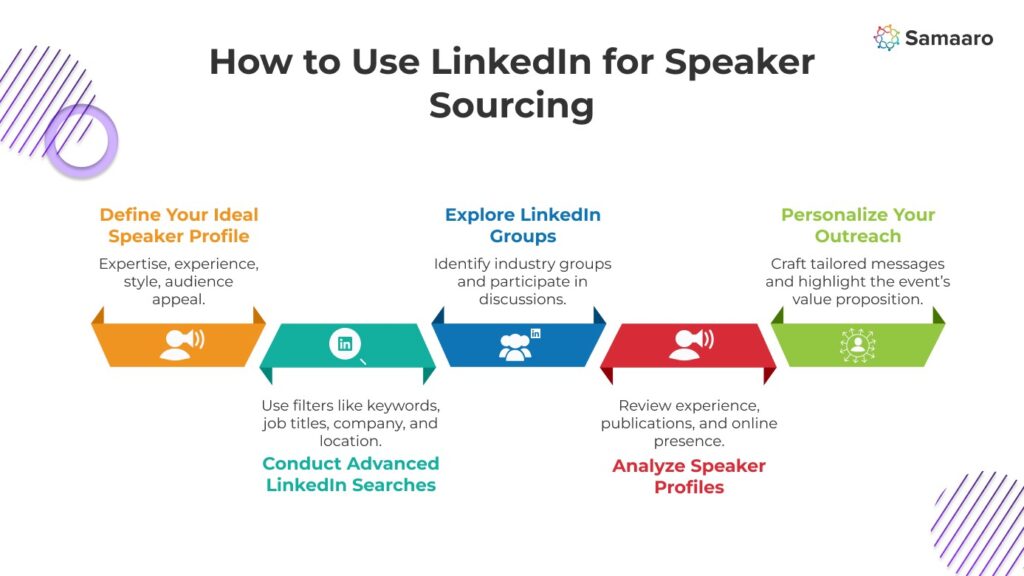
Before diving into LinkedIn’s vast network, it’s essential to define the kind of speaker you’re looking for.
For example, if your event is about AI in marketing, you might look for a seasoned AI professional who has experience delivering case studies or industry trends in an engaging way.
LinkedIn’s search functionality is a game-changer when it comes to finding specific profiles.
“Data Scientist” AND “Conference Speaker” AND “Marketing” AND “Location: ”
These targeted searches will help you uncover profiles of professionals who are not only experts in their field but also have a history of speaking at similar events.
LinkedIn groups are a goldmine for identifying potential speakers.
Once you identify potential speakers, delve deeper into their LinkedIn profiles.
This analysis will help you evaluate whether they’re a good fit for your event and capable of captivating your audience.
Reaching out to potential speakers requires a thoughtful approach.
Example Outreach Message:
Hi ,
I’ve been following your work on , and I’m impressed by your insights on . I’m organizing , focused on , and believe your expertise would add incredible value to our audience.
We would be honored to have you speak on . The event will take place on in , with an expected audience of .
Please let me know if you’d be open to discussing this further—I’d love to explore how we can collaborate!
Warm regards,
Successful speaker sourcing goes beyond just outreach; it’s about building genuine relationships.
By fostering a relationship, you not only increase the likelihood of securing them as a speaker but also build a lasting professional connection.
Securing top-tier speakers for your event requires more than just sending out invitations—it’s about crafting a strategic and respectful outreach process that sets the tone for a professional relationship. Here are some detailed tips to ensure your speaker outreach campaign is successful:
Finding the right speakers can take time, and not every outreach attempt will receive an immediate response. Here’s how to balance patience with persistence:
Example Follow-Up Message:
“Hi , I hope this message finds you well. I wanted to follow up on my earlier email about . We would be honored to have you speak at our event, and I’m happy to answer any questions or discuss details further. Let me know if there’s a good time to connect!”
Every interaction with potential speakers should reflect your professionalism and respect for their time and expertise. Consider these best practices:
Example Initial Outreach Message:
“Hi , I’m , at . We’re organizing on , which focuses on . Given your expertise in , we believe you’d be a perfect fit to inspire our audience of . We’d love to discuss this opportunity further and hear your thoughts. Please let me know if you’d be interested in exploring this!”
Efficient tracking of your outreach efforts helps you stay organized and ensures no potential speaker is overlooked. Here’s how to set up a system:
Example Spreadsheet Columns:
Speakers, especially established ones, may have specific preferences or requirements. Being flexible in your approach can help build trust and encourage them to work with you. Consider the following:
Example Flexibility Message:
“We’re happy to work around your availability and discuss how we can make this opportunity mutually beneficial. Please let us know if there are specific session formats or topics you’re passionate about, and we’ll tailor the event accordingly.”
Speakers are more likely to accept an invitation if they understand the value of participating in your event. Clearly articulate what’s in it for them:
Example Value Proposition Message:
“Our event attracts attendees, including . This is a great opportunity to share your expertise and connect with like-minded professionals. We’d also be happy to provide professional recordings of your session for your use.”
By following these tips, you can create an outreach campaign that is professional, strategic, and speaker-friendly. The right approach not only helps you secure top speakers but also builds lasting relationships that can benefit future events.
LinkedIn is a treasure trove of opportunities for event planners, offering access to a global network of professionals and thought leaders. By defining your ideal speaker profile, leveraging advanced search techniques, and engaging meaningfully with potential speakers, you can secure impactful speakers who elevate your event.
Ready to take your speaker sourcing to the next level? Platforms like Samaaro can help streamline the process, from personalized outreach to managing speaker relationships. Book a demo or start your free trial to see how we can support your event planning journey!
When it comes to event marketing, email remains a cornerstone strategy for engaging attendees, driving registrations, and creating a seamless attendee experience. In 2025, trigger-based emails have taken center stage, revolutionizing how marketers communicate with their audience. These automated, action-based emails ensure your messages reach the right people at the right time, boosting efficiency and outcomes.
This guide dives into the essentials of trigger-based emails, providing actionable tips and examples to help you master this powerful marketing tool.
Trigger-based emails are a transformative approach to email marketing that capitalizes on automation to deliver highly targeted and personalized messages. These emails are sent automatically based on specific actions, behaviors, or predefined criteria, making them incredibly relevant to recipients. Unlike traditional email blasts that cast a wide net with generalized messaging, trigger-based emails are precise, timely, and contextual, significantly increasing their effectiveness.
Trigger-based emails operate by monitoring user interactions or milestones and reacting accordingly. For instance:
The beauty of trigger-based emails lies in their alignment with the recipient’s journey. Here’s why they stand out:
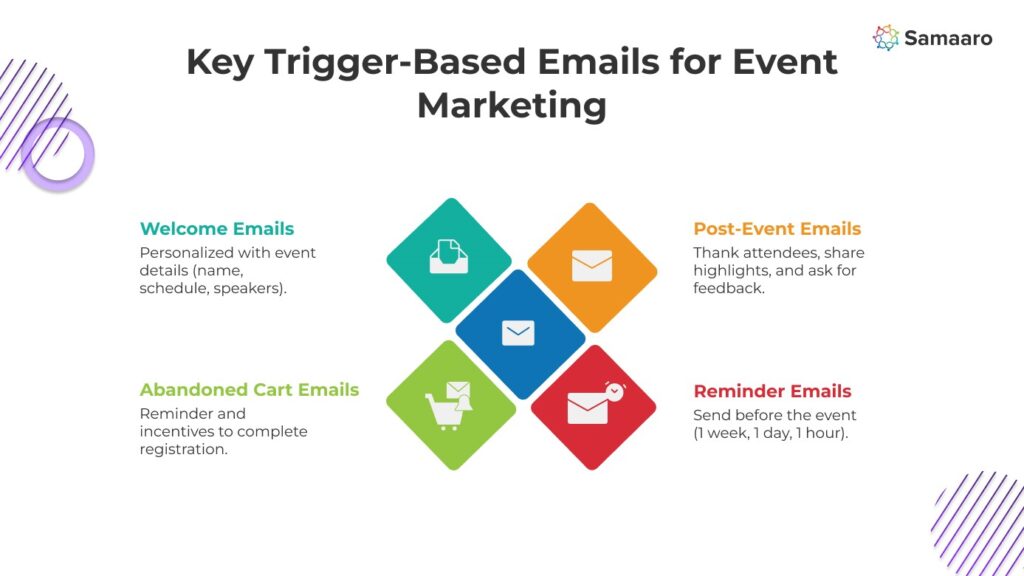
To illustrate their potential, here are some practical examples:
In the dynamic world of events, timing and communication are critical to success. Trigger-based emails ensure that every touchpoint, from registration to post-event follow-up, is strategically aligned with the attendee’s needs. Whether boosting registrations, reducing cart abandonment, or fostering post-event loyalty, trigger-based emails are a vital tool in any event marketer’s arsenal.
By leveraging trigger-based emails, you can transform your email marketing strategy into a personalized, automated, and highly efficient system that builds stronger connections with your audience while driving measurable results.
Welcome emails play a vital role in setting expectations and providing attendees with the information they need to start their event journey. They establish a positive first impression and ensure attendees feel valued.
When Triggered: Upon registration or ticket purchase.
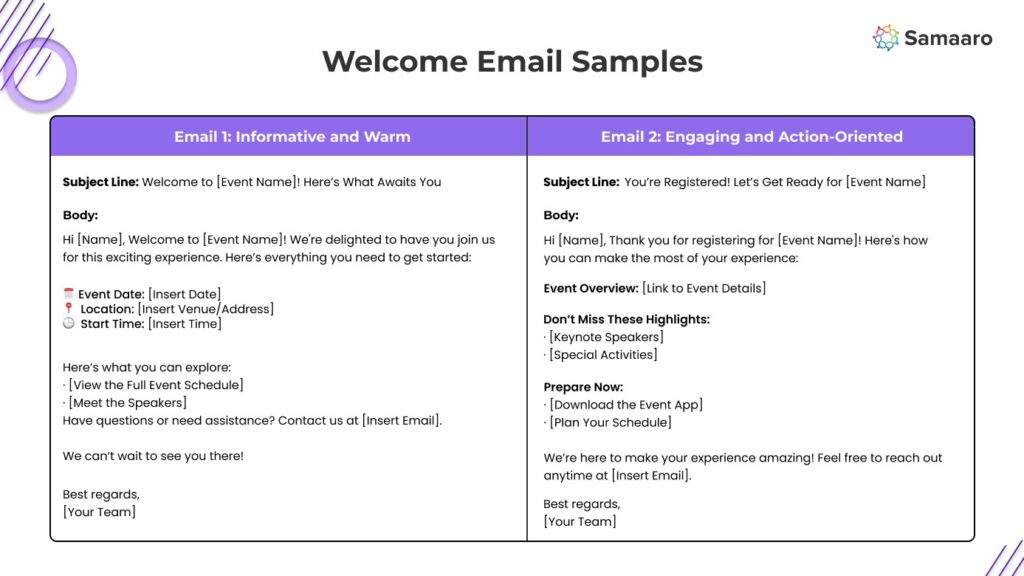
Cart abandonment emails are a gentle nudge to remind potential attendees to complete their ticket purchase. These emails should highlight the value of the event and create urgency to encourage action.
When Triggered: When a user leaves items in their shopping cart without completing registration.
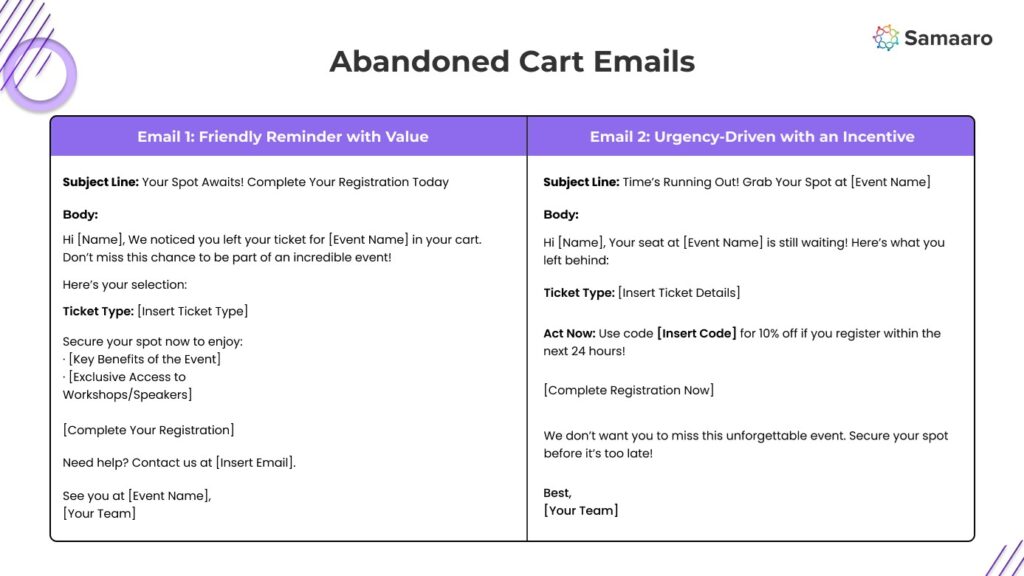
Reminder emails keep attendees informed and excited as the event approaches. These emails ensure attendees are well-prepared and don’t miss out.
When Triggered: 1 week, 1 day, and 1 hour before the event.
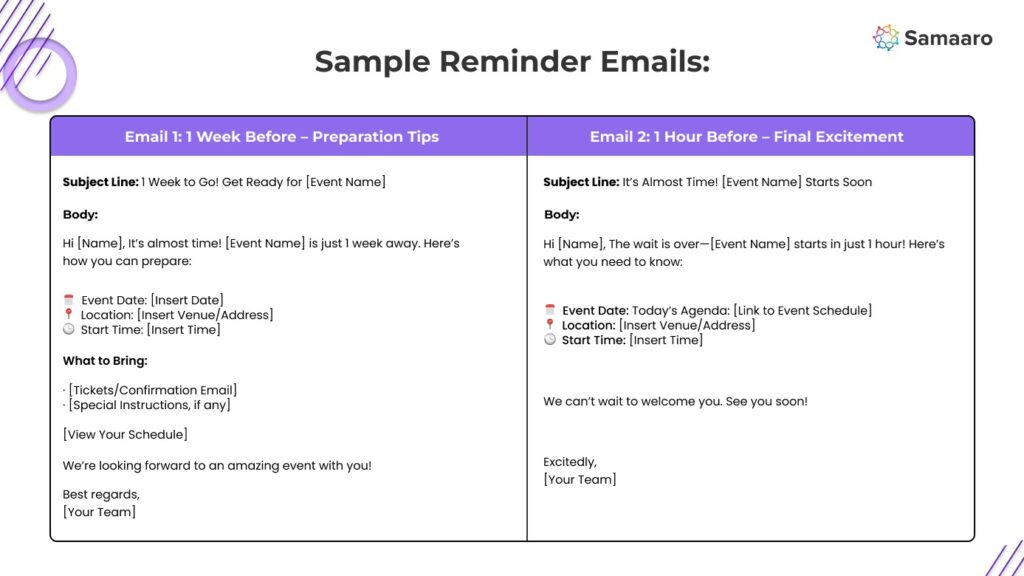
Post-event emails allow you to thank attendees, share highlights, and gather valuable feedback. They’re also an excellent opportunity to nurture relationships and promote future events.
When Triggered: Within 24–48 hours after the event.
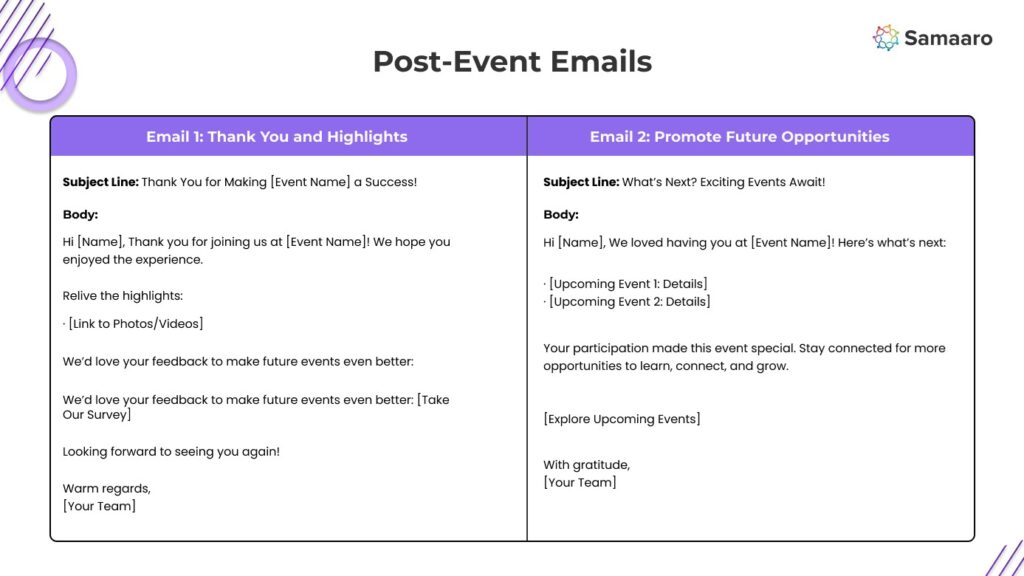
These trigger-based emails not only enhance the attendee experience but also ensure effective engagement throughout the event lifecycle.
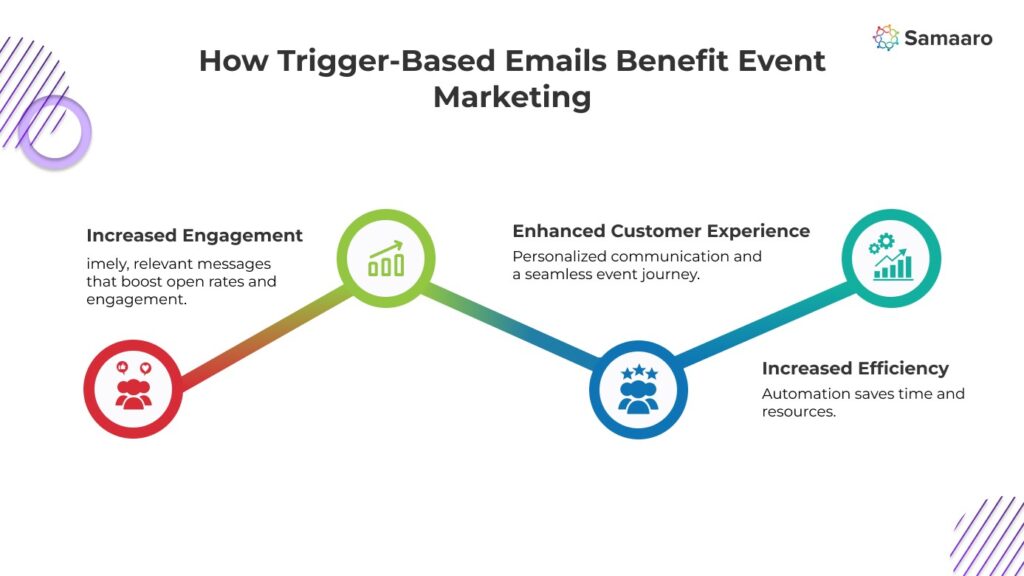
Trigger-based emails offer a range of advantages that make them indispensable for event marketers. Let’s dive deeper into their benefits:
One of the standout benefits of trigger-based emails is their ability to capture attention. These emails are sent in response to specific actions or behaviors, ensuring the message feels relevant to the recipient. When attendees receive an email shortly after registering, leaving their cart, or completing another action, they are more likely to open and engage with it.
Trigger-based emails are a powerful tool for driving conversions. For instance, abandoned cart emails serve as a gentle reminder for prospective attendees who didn’t complete their ticket purchase. By addressing potential barriers—like confusion about pricing or last-minute hesitation—and offering solutions like discounts or extra perks, these emails help secure registrations that might otherwise be lost.
Timely and personalized communication makes attendees feel valued. For example, a welcome email with all the essential details ensures attendees are well-prepared for the event. Similarly, a post-event email that thanks participants and shares highlights fosters a sense of appreciation and belonging.
Trigger-based emails rely on automation, which means your team can focus on higher-value tasks instead of manual follow-ups. Once workflows are set up, emails are sent automatically based on predefined triggers, ensuring consistent communication without extra effort.
How It Helps:
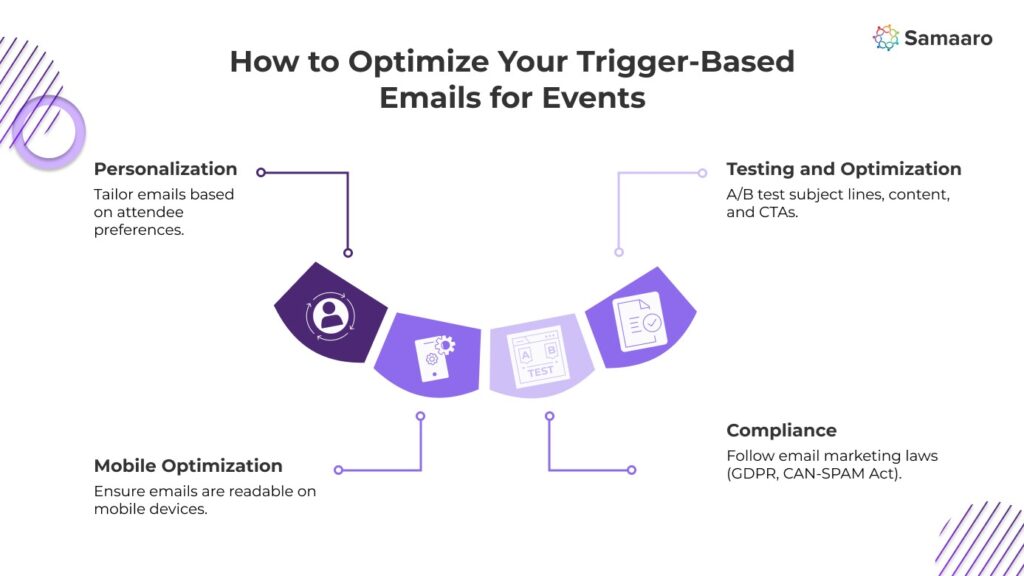
To maximize the effectiveness of trigger-based emails, it’s important to follow these best practices:
Personalization goes beyond adding the recipient’s name to an email. Leverage data to tailor the content to individual preferences and actions. For instance, include the specific ticket type they purchased or recommend sessions based on their interests.
In today’s mobile-first world, many recipients will open emails on their smartphones. If your emails aren’t optimized for mobile, you risk losing engagement and conversions.
A/B testing is essential for refining your email campaigns. Experiment with different elements like subject lines, email layouts, imagery, and CTAs to identify what resonates best with your audience.
Respecting privacy and adhering to email marketing regulations is critical. Failure to comply can lead to penalties and harm your brand reputation.
Trigger-based emails are a game-changer in event marketing. Unlike traditional email campaigns, they are highly targeted, personalized, and action-driven, ensuring your audience receives the right message at the right time. From welcoming attendees to keeping them engaged post-event, these emails help marketers streamline communication and create a seamless attendee experience.
By implementing trigger-based email campaigns, you can elevate your event marketing strategy in 2025. Whether you’re a seasoned marketer or just getting started, platforms like Samaaro can help automate and personalize these campaigns, ensuring your event communication is both efficient and impactful.
Ready to transform your email marketing strategy? Dive into the world of trigger-based emails and watch your events thrive!
Connect with Samaaro today—book a demo or start your free trial to experience how our platform can help you craft and send personalized, automated trigger-based emails for your events.
Social media has become an indispensable tool for event promotion. Whether you’re organizing a corporate seminar, a product launch, or a music festival, an effective social media strategy can amplify your event’s reach and engagement. With millions of users spending hours on platforms like Instagram, Facebook, TikTok, Twitter, and LinkedIn, the opportunity to captivate your audience is immense.
In 2025, the importance of a multi-platform approach cannot be overstated. Each platform caters to a distinct audience with unique preferences. By tailoring your content strategy to each platform, you can create a cohesive, engaging presence that drives attendance and buzz for your events.
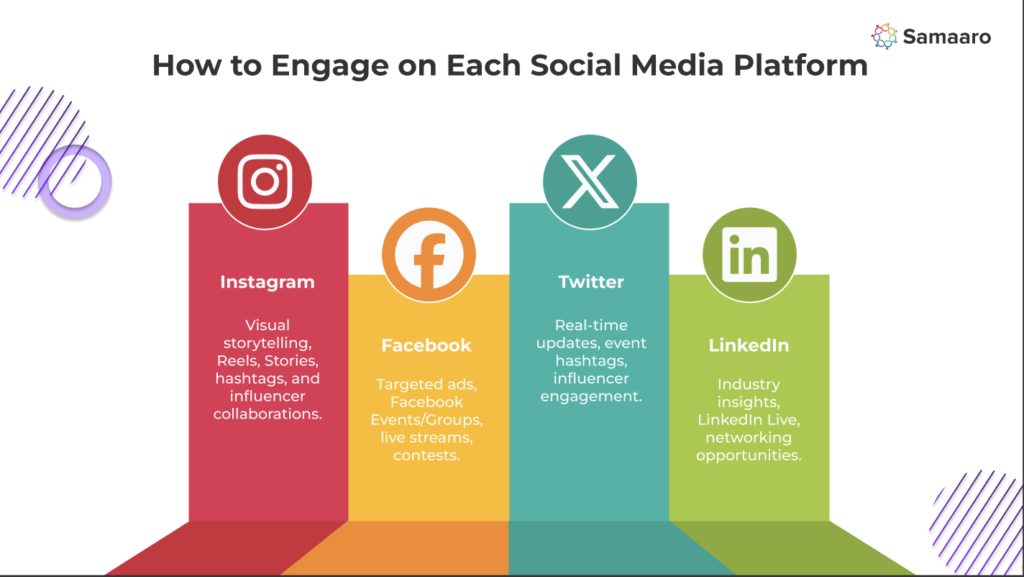
Instagram is the ultimate visual platform, perfect for showcasing the energy and appeal of your events.
Facebook remains a powerhouse for event promotion, particularly for reaching older demographics and professionals.
Twitter excels in real-time engagement and industry discussions.
LinkedIn is ideal for professional and industry-focused events like conferences, workshops, and networking events.
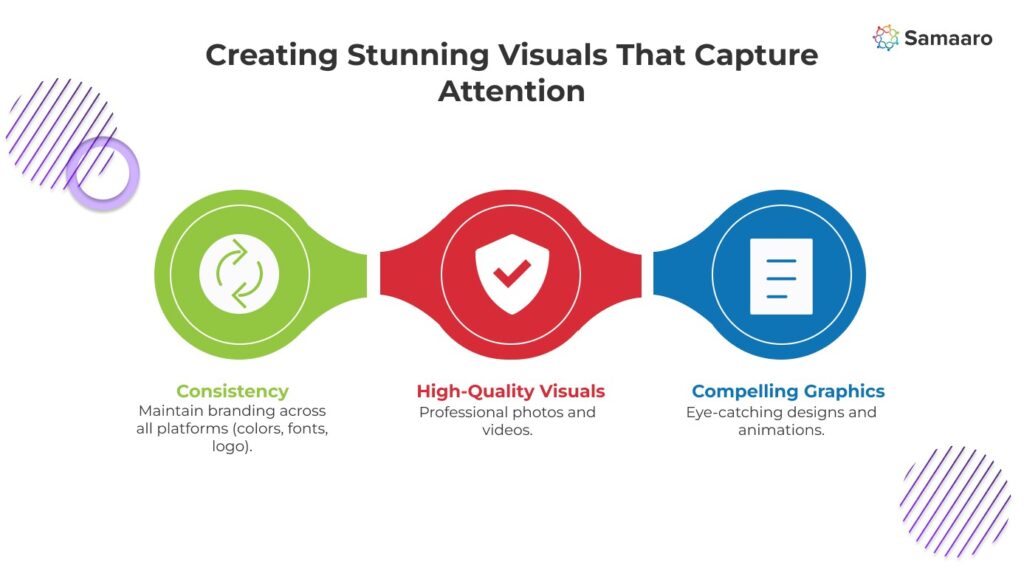
Visual content is one of the most powerful tools for capturing attention and conveying your message effectively. In the fast-paced world of social media, high-quality visuals can make your event stand out and leave a lasting impression. Here’s how to elevate your visual content strategy for events:
Investing in professional-grade visuals is essential for creating a polished and attractive online presence.
Graphics and visuals can simplify complex information and make it more engaging.
A cohesive and consistent visual identity is crucial for brand recognition and trust.
Captions are your opportunity to stop the scroll and capture your audience’s attention. An engaging caption not only draws viewers in but also encourages them to interact and take action. Here’s how to craft compelling captions for your event promotions:
People connect with stories, so share the narrative behind your event. Highlight why you’re hosting it, what makes it special, or how past events have been memorable. For instance:
Make your audience feel involved by posing thought-provoking or fun questions.
Injecting humor and a conversational tone can make your brand more relatable.
Always guide your audience on the next steps.
Influencer marketing is a proven way to amplify your event’s visibility and credibility. Collaborating with the right influencers can significantly boost attendance and engagement.
Start by identifying influencers whose audience aligns with your target demographic. Consider the following:
Influencers value genuine collaborations over transactional ones.
Ensure the collaboration benefits both parties:
Use tools like UTM links or platform analytics to monitor the impact of influencer campaigns. Key metrics to track include:
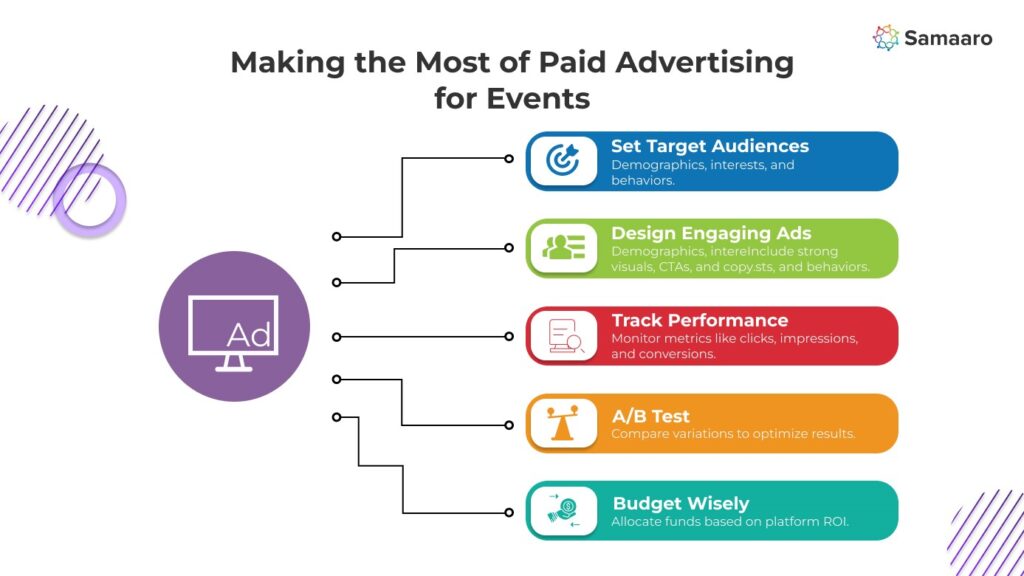
Paid social media ads are essential for reaching audiences beyond your organic following. When executed strategically, they can deliver high ROI and drive significant event awareness.
Each platform requires a tailored approach:
Allocate your budget where it will be most effective:
Experiment with different ad formats and creatives:
Paid advertising allows precise targeting based on:
Keep a close eye on ad performance metrics like:
Regularly optimize underperforming ads to ensure maximum return on investment.
Expanding your strategies for captions, influencer marketing, and paid advertising will significantly enhance the impact of your event’s social media campaigns. By combining engaging content, strategic collaborations, and targeted advertising, your event can achieve remarkable success and visibility.
Crafting engaging social media content for your events in 2025 requires a thoughtful, multi-platform approach. By leveraging platform-specific strategies, high-quality visuals, engaging captions, and influencer partnerships, you can create a buzz that attracts and excites attendees.
Remember, social media strategies are not static. Monitor your campaigns, analyze performance metrics, and adapt your approach to ensure continued success.
With the right tools and strategies, social media can transform your event into an unforgettable experience. Let Samaaro, an AI-powered event marketing platform, help you plan and execute a winning social media strategy for your next event. Schedule a demo today and take the first step toward creating memorable, impactful events.
Micro-events are becoming increasingly popular in today’s business world, offering unique and memorable experiences that create stronger relationships between brands and their target audiences. Unlike large-scale conferences or trade shows, micro-events are typically smaller, more intimate gatherings that focus on creating deeper connections and delivering value in a more personalized way.
These events are ideal for companies looking to engage their audiences in a meaningful way without the extensive logistics of large gatherings. Samaaro, an AI-powered event marketing platform, provides event planners with the tools they need to plan, execute, and measure micro-events with ease. In this guide, we’ll explore the benefits of micro-events and how to plan one that’s sure to leave a lasting impression on your guests.

One of the primary advantages of micro-events is the ability to foster deeper engagement. With fewer attendees, there’s more opportunity for meaningful, one-on-one interactions. The intimate setting allows guests to feel more comfortable sharing their thoughts, providing valuable feedback, and engaging in discussions with the host or other attendees. This leads to higher levels of audience participation and can translate into more significant business opportunities, partnerships, or even sales.
Micro-events are often more cost-effective compared to large conferences or trade shows. With a smaller guest list, expenses related to venue rental, catering, and event materials are significantly reduced. The ability to be more selective with your guest list allows you to focus your resources on high-value attendees, increasing your return on investment. With Samaaro’s targeted marketing and audience segmentation tools, you can ensure that your marketing efforts are aimed at the most relevant prospects, maximizing ROI.
Another key benefit of micro-events is the flexibility they offer. Unlike large-scale events that require months of preparation, micro-events can often be planned and executed within a shorter time frame. Whether it’s an intimate networking dinner or a hands-on product demonstration, the smaller scale allows for faster decision-making and greater agility. Additionally, micro-events are easier to adapt to changing circumstances, giving you the ability to pivot if needed.
Micro-events are an excellent opportunity to create lasting brand impressions. Because these gatherings are typically more personal and interactive, they allow brands to showcase their products or services in a more impactful and engaging manner. Attendees leave with a stronger emotional connection to the brand, which leads to greater brand loyalty and advocacy. With Samaaro’s event marketing tools, you can create customized experiences that make your brand stand out and leave a lasting impression.
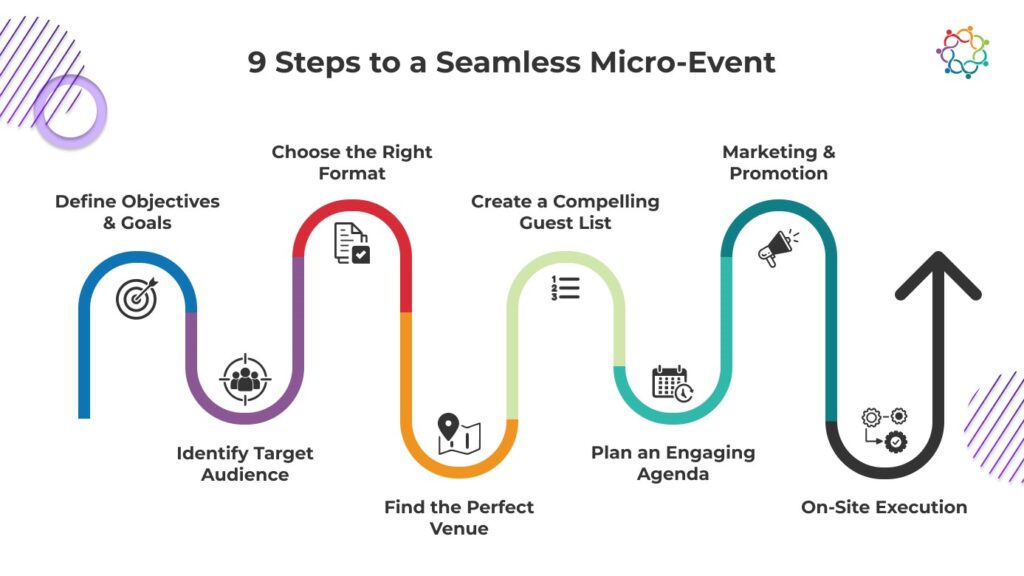
The first step in planning any successful event is to clearly define your objectives. What do you hope to achieve with your micro-event? Whether it’s networking, product launches, team-building, or client appreciation, your goals should align with your business objectives. Use the SMART framework—Specific, Measurable, Achievable, Relevant, and Time-bound goals—to create clear outcomes for the event.
Knowing your audience is critical to the success of your micro-event. The smaller scale means you need to be more deliberate in selecting attendees who align with your event’s purpose. Are you targeting potential clients, influencers, employees, or partners? Samaaro’s audience segmentation tools allow you to pinpoint the right people to invite, ensuring that your event reaches those most likely to benefit from it.
Micro-events come in many different forms, from intimate dinners and product demonstrations to client appreciation events and networking workshops. The format you choose should align with your goals. For instance, if your objective is to showcase a new product, a hands-on demonstration would work best. On the other hand, if you’re looking to strengthen relationships with key clients, a private dinner might be more fitting. Samaaro can help you tailor your event format to suit your needs.
The venue you choose will set the tone for your micro-event. Consider intimate, unconventional venues that match the scale and vibe of your gathering. Private residences, art galleries, upscale restaurants, and boutique hotels all work well for micro-events. Samaaro’s venue sourcing tools can help you discover the ideal location for your gathering, ensuring it aligns with your vision.
With micro-events, the guest list is everything. Since the event is small, every attendee counts. Use Samaaro’s CRM integration to manage your guest data, making it easy to personalize invitations and keep track of RSVPs. Be sure to carefully select individuals who will bring value to the event and fit the profile of your ideal attendee.
A compelling agenda is key to a successful micro-event. With a smaller group, you can design an interactive agenda that fosters meaningful connections. Incorporate interactive activities, discussions, or surprise elements that will engage your audience and make the experience memorable. Samaaro can help you streamline this process by providing tools to manage the schedule and track attendee engagement.
Even though micro-events are small, you still need to market them effectively. Use a mix of personalized emails, social media promotions, and direct invitations to reach your target audience. Samaaro’s marketing automation tools allow you to design and execute highly targeted campaigns that maximize your event’s visibility and reach. You can also segment your audience for tailored messaging, ensuring you attract the right attendees.
The success of your micro-event depends on flawless execution. From checking in guests to managing the event flow, everything must be seamless. Samaaro’s event management features allow you to handle logistics on-site, ensuring smooth operations. After the event, use Samaaro to gather real-time feedback from attendees, helping you make improvements for future events.
Follow-up is essential to continue building relationships after the event. Send personalized thank-you notes to attendees, share event highlights, and follow up on any potential leads or business opportunities. Use Samaaro’s analytics tools to gather data on your event’s performance, including attendee engagement and feedback, to help refine your future micro-events.
Micro-events are a powerful tool for building stronger relationships and creating memorable brand experiences. By carefully planning and executing these smaller, more intimate gatherings, businesses can enhance engagement, strengthen brand impressions, and achieve higher ROI. Samaaro provides all the tools you need to plan, market, and measure your micro-events effectively, ensuring they leave a lasting impact.
With its easy-to-use features, Samaaro simplifies the entire event process, from audience segmentation and venue sourcing to marketing automation and post-event follow-up. Ready to plan your next micro-event? Book a demo with Samaaro today and discover how our platform can help you create successful, high-impact events.

Built for modern marketing teams, Samaaro’s AI-powered event-tech platform helps you run events more efficiently, reduce manual work, engage attendees, capture qualified leads and gain real-time visibility into your events’ performance.


© 2025 — Samaaro. All Rights Reserved.